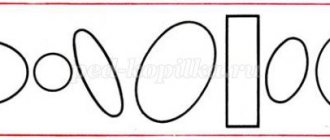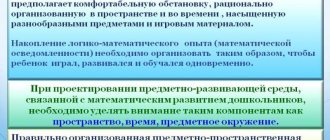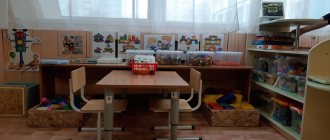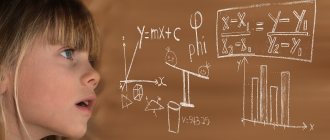Organization of activity centers for children of senior preschool age in a kindergarten group
The article is devoted to the issues of organizing a modern educational environment in a preschool institution in accordance with the Federal State Educational Standard for Preschool Education. The article presents the experience of teachers in organizing children's activity centers: the center for mathematical and sensory development “Pochemuchka”; ecology and experimentation; local history; security; speech development and books; visual arts, music and theater; physical education and health center.
Key words: Federal State Educational Standard for Preschool Education (FSES DO), preschool education, game, developing subject-spatial environment, children's activity centers, children's initiative, senior preschool age.
The Article is devoted to the organization of a modern educational environment in a preschool institution in accordance with Federal state educational standard of preschool education. The article presents the experience of teachers on the organization of children's activity centers: center for mathematical and sensory development “Pochemuchka”; ecology and experimentation; local history; security; speech and books; fine art, music and theater; the center of physical education and health.
Key words: Federal state educational standard of preschool education (FSES TO), preschool education, games, educational subject-spatial environment, children's activity centers, children's initiative, senior preschool age.
From the position of psychologists such as L. S. Vygotsky, P. Ya. Galperin, V. V. Davydov, A. N. Leontiev, D. B. Elkonin, a developmental environment is a certain ordered educational space in which developmental learning is carried out . Most experts use the concept of Doctor of Psychological Sciences S. L. Novoselova: “A developing subject environment is a system of material objects of a child’s activity that functionally modernizes the content of the development of his spiritual and physical appearance. An enriched developmental environment presupposes the unity of social and natural means of ensuring a child’s varied activities. The main elements of the subject environment are large-sized construction kits (modules) commensurate with the child’s height; themed sets of toys and aids; audiovisual and information means of education and training" [4].
According to R.B. Sterkina, it is in kindergarten that it is possible to organize an environment aimed at “harmonization in terms of quantity, diversity, originality, variability, and the degree of influence on the child’s personality.”
The French teacher S. Frenet believed that thanks to the environment, the child independently develops his inclinations, abilities, capabilities, but the adult plays an important role in this, since it is he who creates the subject-spatial environment. Modern domestic scientists and teachers, for example N. Ya. Korotkova, N. A. Mikhailenko and others, believe that the saturation of the space surrounding a child should always correspond to his age characteristics, therefore changes in the environment are necessary in accordance with the development and growth of needs and interests children [8].
It is no secret that play occupies an important, fundamental place in the development of preschool children and is the leading type of their activity. Therefore, the developing subject-spatial environment of our group provides an opportunity to support the play activities of pupils, helps us identify and develop children’s abilities in any form of the educational process.
We organize activity centers based on the integration of types of children's activities, taking into account the requirements of the Federal State Educational Standard for Education, which recommend compliance with the following principles:
— Transformability, which implies the possibility of changing the subject-development environment depending on the areas of activity and the educational tasks being solved.
— Multifunctionality, which provides not only options for the varied use of various components of the subject-development environment, depending on the topic of activity, but also lines of succession between all components of the educational process.
— Expediency, providing the subject-developmental environment of the group with the necessary and sufficient content, which gives children opportunities for self-expression.
— Variability, determined by the content of regional education, national, cultural and artistic traditions of the region.
— Informativeness, providing for a variety of topics of children's activities, as well as materials and equipment used by children in the process of activity [9].
The goal of the Pochemuchka Center for Mathematical Development is to create conditions for the development of logical thinking and sensory culture. According to M.N. Polyakova, the subject content of the mathematical development of preschool children includes three groups of subjects: games, didactic, educational and methodological material and equipment [5]. Due to the fact that older preschoolers begin to intensify their interest in future schooling, there is a need for its support and development. Therefore, the center includes school paraphernalia: a backpack, educational notebooks, rulers, pens and pencils, educational books. Also, in the center there is a place for entertaining mathematics, where there are: clock models, counting sticks, geometric lotto, various puzzles, labyrinths, cut-out pictures, books with entertaining problems, creative games “Tangram”, “Columbus Egg”, Nikitin cubes, Montessori frames, Cuisenaire sticks, Dienesh blocks, Voskobovich games, chess and checkers. As well as games for the development of fine motor skills: mosaics of different shapes, sizes and colors. Children use geometric shapes and counting sticks as building materials. As the games are mastered, more complex games are introduced with new, entertaining material that is not yet familiar to the child. The main task of the teacher is to create conditions for the manifestation of independence and the further development of children’s interest in entertaining games; for this we use the recommendations of T. V. Taruntaeva [7].
Construction center. All building material (small and large) in a group is located in one place, stored on open shelves, in plastic boxes and containers. This center has construction sets of various sizes and types, building materials, and transforming toys. We also use soft modules in children’s constructive activities, which are designed for building interesting structures.
. Children learn to listen and distinguish sounds: the murmur of water, the singing of birds, and enjoy the beauty of flowering plants. Observing the world around them, they gradually come to understand that nature can not only be enjoyed, admired, admired, but that it needs help, caring hands and protection. Therefore, it is important for teachers to create conditions for the accumulation of personal experience of preschoolers when interacting with nature [1]. This center has a geographical map of the world, a globe, a nature and weather calendar, where children note the weather daily, educational encyclopedias, and educational games. A mini-laboratory has been organized in the center, in which there is waste material of various sizes and shapes for conducting experiments: cups of yoghurt, ice cream, cake boxes, plastic spoons for bulk materials, sticks, cocktail tubes, filter paper ( napkins), pinwheels, to determine the direction and strength of the wind during a walk. Also in the laboratory are stored natural materials intended for various studies, sand, clay, stones, plant seeds, straws, etc. At an older age, the main goal of research activities becomes acquaintance with various simple technical means that help to understand the world (magnifying glass, microscope , magnet, scales), hourglasses, flasks, test tubes, set for playing with water, mills, for playing with sand [1]. Natural material is multifunctional: children use it in the center of artistic creativity for crafts, in the center of mathematical and logical games to consolidate counting.
Taking into account the principle of expediency of the Federal State Educational Standard for Education, which provides the subject-developmental environment of the group with the necessary and sufficient content, a play area has been organized in the group, which allows creating conditions for enriching the social and moral orientations and feelings of children, the rules of relations between adults and children; formation of friendly and friendly relationships in the children's team. The play area is equipped with attributes for role-playing games, selected taking into account the age and individual characteristics of children. In the play area there is, not fixed in a rigid way, equipment for role-playing games, most of which are stored in boxes that have a picture and an inscription to recognize the game: children independently determine what games they will play.
The centers do not have rigid boundaries, which allows the principle of transformability to be observed [9].
For this purpose, we have a portable screen in our group. Using it, children can make a room for playing, leaf through their favorite book, look at photographs in a family album, or just sit and take a break from the children's group. By fencing off from the common space, the child creates his own little world.
"Gender Center". When creating the environment of our group, we were guided by safety standards and compliance with sanitary and hygienic requirements, taking into account the principles of the gender and age characteristics of children, the interests, and inclinations of boys and girls. [6]. In preschool age, the process of gender-role socialization occurs intensively. By the end of preschool childhood, the sexual differentiation of the interests of boys and girls is very significant: gender-role preferences, value orientations, desires and motives that are specific to gender and associated with the development of the qualities of masculinity and femininity are formed [2]. Boys love to play with cars; for this purpose, a place was allocated in the center for a “garage” and a stand for tools was attached; there are also sets of soldiers and military equipment. Girls are more willing to play “mother-daughter”, “go” to the beauty salon, to the store, and play at school. The following attributes have been selected for them: a sewing machine, irons, ironing board, household appliances, dishes, dolls, cribs and strollers, sets for story games “Barbershop”, “Hospital”, etc.
“Our Motherland is Russia.” The center was organized taking into account the principle of variability. The main task of this center is to introduce children to the history, culture, and natural features of our country, republic, to instill patriotism, to get acquainted with folk crafts and the life of Russians and Khakassians. In the center there are: the Russian flag, the flag of the Republic of Khakassia, the Russian coat of arms and the coat of arms of Khakassia, the anthem of the Russian Federation, the anthem of Khakassia, books, postcards, photo albums, dolls in national costumes. Mini-museums have been decorated: “Russian Izba”, “Khakassia - My Native Land”, which display models of ancient dwellings and various household utensils.
The task of the “Safety Center” is to introduce and master knowledge about traffic rules, fire safety and rescue services. Therefore, at the security center we made a model of a road intersection, road signs, and vehicle models; lapbook on road and fire safety “Good Road”, “Fire Safety”; dolls in professional clothes of a firefighter and traffic police inspector, attributes for role-playing games (steering wheels, vests, caps, hats, “fire extinguishers”, etc.). As well as didactic games and situations on safe behavior at home, on the street, in nature, and when communicating with strangers.
"Literary and theatrical" center. At an older age, a steady interest in books arises, a desire to constantly communicate with them, and a desire to get acquainted with new works. Children strive to share with others their impressions of what they have read, discuss the contents of the book, the behavior of the characters, talk about their experiences, retell the story they liked, read their favorite poem. For this purpose, the center has selected colorful books and encyclopedias [1]. The main idea of this center is to show how different books are, to introduce children to their history. Children show interest in the past, present, and future. For this purpose, the group has materials for better perception of stories: supporting pictures, toys, illustrations. To get to know children's writers, there are their portraits in the corner. In the center there is a mini-library with interesting books, which are updated in accordance with the theme of the week.
Theatrical activity is the most common type of children's creativity. It is close and understandable to the child because it is connected with the game. The child wants to translate any of his inventions, impressions from the life around him into living images and actions. By entering the role, each child has the opportunity to demonstrate their abilities, become successful, and try themselves in any role. In the corner of theatrical activities there are various types of theaters (finger, shadow, table, mitten theater, theater on flannel, etc.), thematic sets of toys, manuals, a lapbook “Visiting a fairy tale,” masks of fairy tale characters that can be used in active and role-playing games.
There is a tape recorder and an audio library for listening to a variety of works. Pupils, on their own initiative, apply their musical experience in a wide variety of activities. Children learn to play musical instruments: metallophone, harmonica, pipes, children's piano, tambourines, drums. Children use instruments individually, sometimes they organize an “orchestra”. The center has various didactic games: “Musical Lotto”, “Guess who is singing”, “Name the song from the picture”, etc., which develop children’s ability to perceive and distinguish the basic properties of musical sound.
. Visual arts are one of the most favorite activities among children, so a well-lit place was chosen for him, away from playing children, where pupils show their creativity in their free time. In the center there is a mini-museum “Folk Art”, which is filled with small sculptures. The necessary visual material is freely available to children (crayons, pencils, felt-tip pens, paper of different textures, sizes and colors, stencils, felt-tip pens, brushes of different sizes, palette, coloring books, plasticine, clay, natural and waste materials). Pupils are also offered didactic games (“Complete the pattern”, “Make a still life”, etc.).
Fitness and fitness center. The group includes mats for foot massage of different textures. For the health track we use ribbed mats, ropes, cords, ropes of different thicknesses. To develop manual dexterity, we offer children rubber, medicine and massage balls, ring throws, a mini basketball hoop, and skittles. To correct posture, there are gymnastic sticks, jump ropes, and hoops. All sports equipment is stored on racks and shelves on wheels.
A properly organized developmental environment allows every child to find something they like, show children’s initiative, and believe in their strengths and abilities. An indispensable condition for its construction is reliance on a person-oriented model of interaction between children and adults. From this we conclude that the developing subject-spatial environment performs the most important functions: informational and developmental. The developmental environment includes a variety of subjects and objects of social reality, where each subject and object carries certain knowledge about the world around us and becomes a means of transmitting social experience.
Literature:
- Babaeva T. I., Gogoberidze A. G., Solntseva O. V., etc. Childhood: An exemplary educational program for preschool education / St. Petersburg: Publishing House “Childhood-Press” LLC, 2014.
- Babaeva T. I., Mikhailova Z. A. Game and preschooler. Development of children of senior preschool age in play activities: Collection - St. Petersburg: “Childhood - Press”, 2004.
- Doronova T. N., Karabanova O. A., Solovyova E. V. Playing in preschool age. M., 2002.
- Novoselova S. L. Developing subject environment: Methodological recommendations for the design of variable design projects for developing subject environment in kindergartens and educational complexes.//Series: Instructional and methodological support for the content of education in Moscow/-M. Center for Innovation in Pedagogy. 1995
- Polyakova M.N. Designing models of a subject-development environment: Methodological recommendations for preschool workers. - St. Petersburg: Publishing House of the Russian State Pedagogical University named after A. I. Herzen, 2006.
- SanPiN2.4.1.3049–13.
- Taruntaeva T.V. Development of elementary mathematical concepts in preschoolers. - M.: Education, 1980.
- Tomchik G.P. Organization of the subject-development environment of a preschool educational institution in connection with the introduction of the Federal State Educational Standard // Preschooler (preschooler. r.f.): online magazine. [Electronic resource]. URL: https://doshkolnik.ru./pedagogika/7854-sreda html
- Federal State Educational Standard for Preschool Education (approved by order of the Ministry of Education and Science of the Russian Federation dated October 17, 2013 No. 1155)






